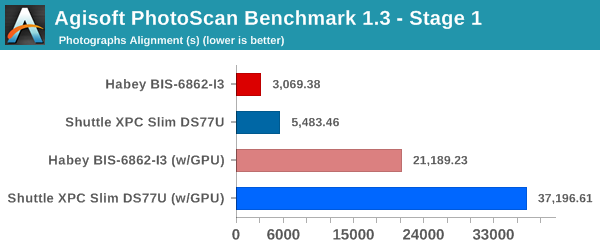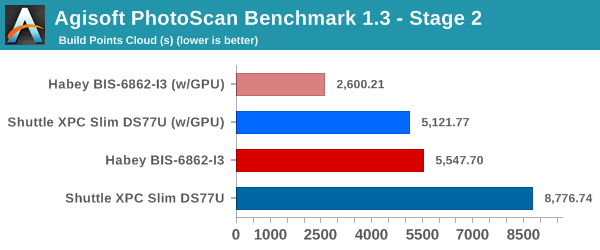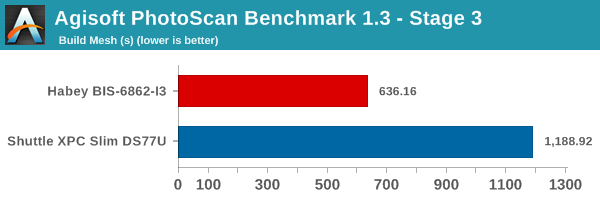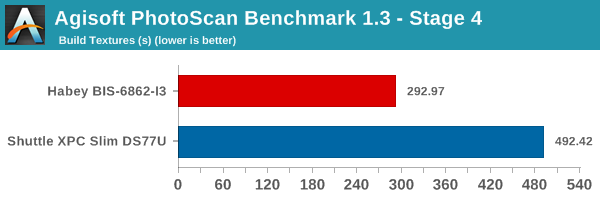Habey BIS-6862 & Shuttle XPC Slim DS77U Fanless Kaby Lake Industrial PCs Review
by Ganesh T S on January 5, 2018 8:00 AM ESTPerformance Metrics - II
In this section, we mainly look at benchmark modes in programs used on a day-to-day basis, i.e, application performance and not synthetic workloads.
x264 Benchmark
First off, we have some video encoding benchmarks courtesy of x264 HD Benchmark v5.0. This is simply a test of CPU performance. As expected, the Habey unit comes behind the Core i5-based Logic Supply units. The Shuttle unit is the better than the Atom-class systems, but, not as good as the other Core-based ones. Recent releases of the x264 benchmark can show even more impressive gains, as they make use of the latest and greatest features of the modern Intel processors.


7-Zip
7-Zip is a very effective and efficient compression program, often beating out OpenCL accelerated commercial programs in benchmarks even while using just the CPU power. 7-Zip has a benchmarking program that provides tons of details regarding the underlying CPU's efficiency. In this subsection, we are interested in the compression and decompression MIPS ratings when utilizing all the available threads.


TrueCrypt
As businesses (and even home consumers) become more security conscious, the importance of encryption can't be overstated. CPUs supporting the AES-NI instruction for accelerating the encryption and decryption processes have become more widespread over the last few years. TrueCrypt, a popular open-source disk encryption program can take advantage of the AES-NI capabilities. The TrueCrypt internal benchmark provides some interesting cryptography-related numbers to ponder. In the graph below, we can get an idea of how fast a TrueCrypt volume would behave in the Habey BIS-6862-I3 and the Shuttle XPC Slim DS77U, with a comparison against other select PCs. This is a purely CPU feature / clock speed based test.

Agisoft Photoscan
Agisoft PhotoScan is a commercial program that converts 2D images into 3D point maps, meshes and textures. The program designers sent us a command line version in order to evaluate the efficiency of various systems that go under our review scanner. The command line version has two benchmark modes, one using the CPU and the other using both the CPU and GPU (via OpenCL). We have been using an old version of the program with 50 photogaphs in our reviews till now. The updated benchmark (v1.3) now takes around 84 photographs and does four stages of computation:
- Stage 1: Align Photographs (capable of OpenCL acceleration)
- Stage 2: Build Point Cloud (capable of OpenCL acceleration)
- Stage 3: Build Mesh
- Stage 4: Build Textures
We record the time taken for each stage. Since various elements of the software are single threaded, others multithreaded, and some use GPUs, it is interesting to record the effects of CPU generations, speeds, number of cores, DRAM parameters and the GPU using this software.
Stage 1 shows great benefits from GPU with systems having discrete GPUs. However, enabling them with the integrated GPU in the Intel processors seems to be detrimental compared to a pure CPU-based run. On the other hand, Stage 2 shows GPU acceleration delivring better results as expected.




Dolphin Emulator
Wrapping up our application benchmark numbers is the new Dolphin Emulator (v5) benchmark mode results. This is again a test of the CPU capabilities, and the Habey system takes lesser time to complete the benchmark compared to the Shuttle unit.











13 Comments
View All Comments
MrTeal - Friday, January 5, 2018 - link
I'm not sure they will, really. Most of them will tend to be 19V input because they leverage laptop parts, or often 24V (sometimes 12V) as that is incredibly common in industrial setups and control systems.5V works well for things like compute sticks, but you generally don't see much of it in PLC cabinets and the like.
Reflex - Friday, January 5, 2018 - link
Given the market these things go into I am not surprised they are avoiding support for OS's that will be out of support from MS soon. Usually these things run in an environment for 5-10 years so there is little need to support anything that will lose support prior to that end date.mjeffer - Sunday, January 7, 2018 - link
Kaby Lake is only supported on Windows 10 IIRC.